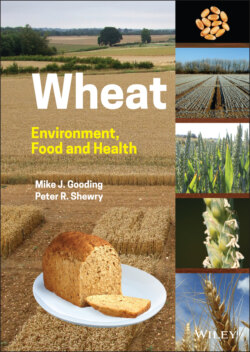Читать книгу Wheat - Peter R. Shewry - Страница 28
1.3.3 Domestication
ОглавлениеGenetic changes occurred as gatherers and early farmers selected traits in the wild diploid and tetraploid species that facilitated their cultivation, giving rise to distinct cultivated forms that are regarded here as variety groups (var.). Variety groups within the Triticum species are sometimes referred to as subspecies (subsp.) in other classification systems. The cultivated forms of wheat have traits collectively known as the domestication syndrome. Two traits have been particularly important in the domestication of wheat. The first is the loss of shattering of the spike at maturity through having a semi‐tough rachis. It is important for the rachis of mature ears of wild plants to be brittle, such that the ear shatters or disarticulates to aid seed dispersal. By contrast, mutations at the Br (brittle rachis) loci on the short arms of group 3 chromosomes (Nalam et al. 2006) confer a semi‐tough rachis that keeps the ear intact. This prevents seed loss before manual harvesting; although this is highly advantageous to gatherers and farmers, it represents a significant loss of fitness for the wild plant. The appearance of the non‐shattering phenotype in the archaeological record is, therefore, often assumed to be confirmation of wheat cultivation (Allaby et al. 2017). However, it is also likely that cultivation of wild types predated that of domesticated forms. Both shattering and non‐shattering forms are found within the Fertile Crescent dated to the same time, and often within the same site (Tanno and Willcox 2012). There are very early dates for the first possible appearance of non‐shattering einkorn (> 11 000 BP) and emmer (> 10 000 BP), at camps or settlements where shattering types dominated (Allaby et al. 2017). Thereafter the shift from non‐shattering to shattering forms was a slow evolutionary process. The greatest selection pressures from the presumed adoption of cultivation are estimated to be from 10 500 to 9500 BP (Allaby et al. 2017), but the complete transition to domesticated forms probably took three to four millennia (Fuller et al. 2012). Today, all cultivated forms of wheat have a semi‐tough rachis.
The second important change in domestication has been the transition from hulled forms in which the grain is harvested within glumes and other spikelet structures (Figure 1.12), to free‐threshing forms in which grains are released naked during harvesting processes. The free‐threshing trait of wheat arose by a dominant mutant at the Q locus which modified the effects of recessive mutations at, e.g. the Tg (tenacious glume) locus on the group 2 chromosomes (Dubcovsky and Dvorak 2007; Kilian et al. 2009). Not all cultivated forms of wheat yield naked grain at harvest. For example, most cultivated einkorns are hulled ( T. monococcum var. monococcum). However, the var. sinskajae has free‐threshing grain and can be used as a source of this trait in einkorn breeding programmes.
Wild emmer ( T. turgidum var. dicoccoides) has given rise to several cultivated tetraploid variety groups. Cultivated emmer (var. dicoccum) is hulled but the most widely grown form is free‐threshing durum wheat (var. durum). Durum wheat accounts for about 5% of global wheat production. It is particularly adapted to Mediterranean climates and is mostly used for making pasta and regional foods such as couscous and bulgar. Other free‐threshing variety groups are only cultivated to a limited extent. These minor groups include rivet wheat (var. turgidum), Polish wheat (var. polonicum), Persian wheat (var. carthalicum), and Khorasan wheat (var. turanicum). T. timopheevi is represented in both hulled (var. timopheevi) and naked forms (var. militinae) and is still cultivated in small areas in the Caucasus.
Cultivated einkorn and emmer clearly developed from the domestication of natural populations. By contrast, hexaploid wheat ( T. aestivum, genome formula AABBDD) has never existed as a wild species. It originated through hybridisation of cultivated emmer with the wild goat grass Aegilops tauschii (also called Triticum tauschii and Ae. squarrosa), which contributed the D genome (Figures 1.13 and 1.15). This hybridisation probably occurred several times, with farmers selecting hexaploid lines for their larger grains and higher yields. Modern wild populations of Ae. taushcii are found growing in the north and northeast of the Fertile Crescent and populations carrying genomes closely related to the D genome of hexaploid wheat occur in Transcaucasia, between the Black Sea and the Caspian Sea (particularly in modern‐day Armenia), and around the southwest of the Caspian Sea (modern‐day northern Iran) (Dvořák et al. 1998). The first hexaploid wheats may, therefore, have occurred around the south or west of the Caspian Sea about 8000 BP (Kilian et al. 2009).
